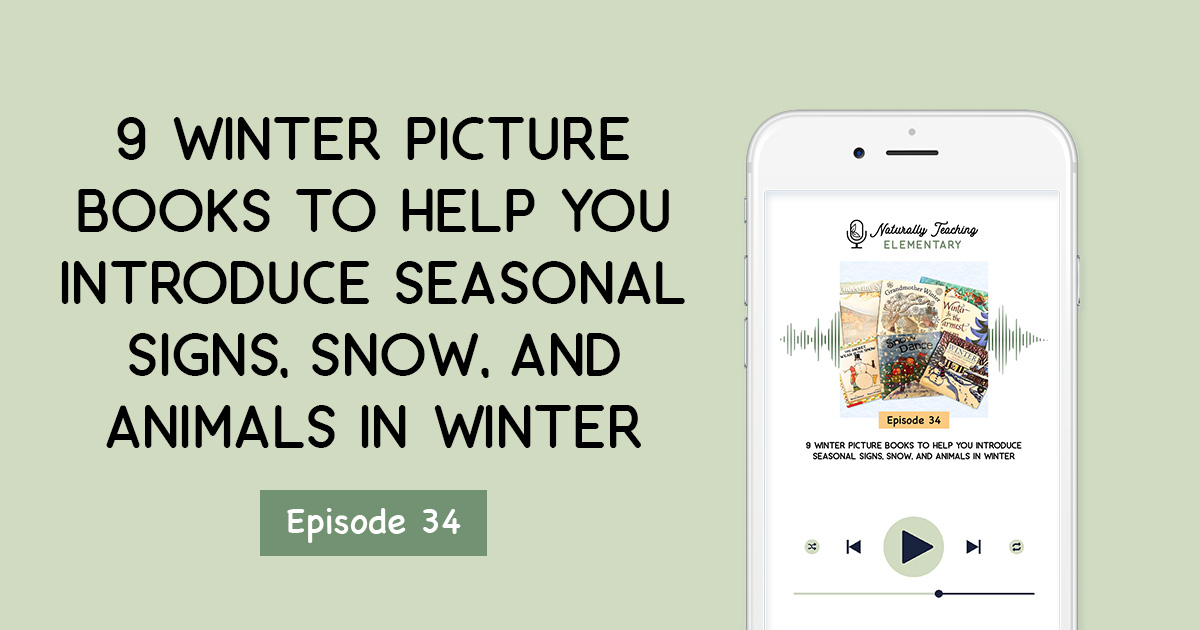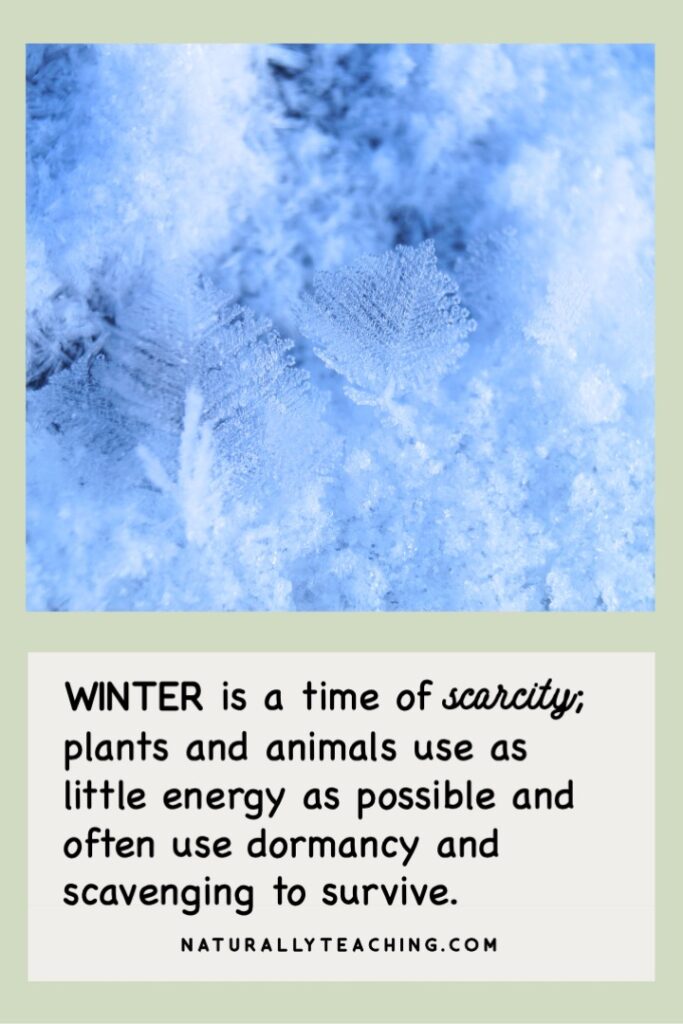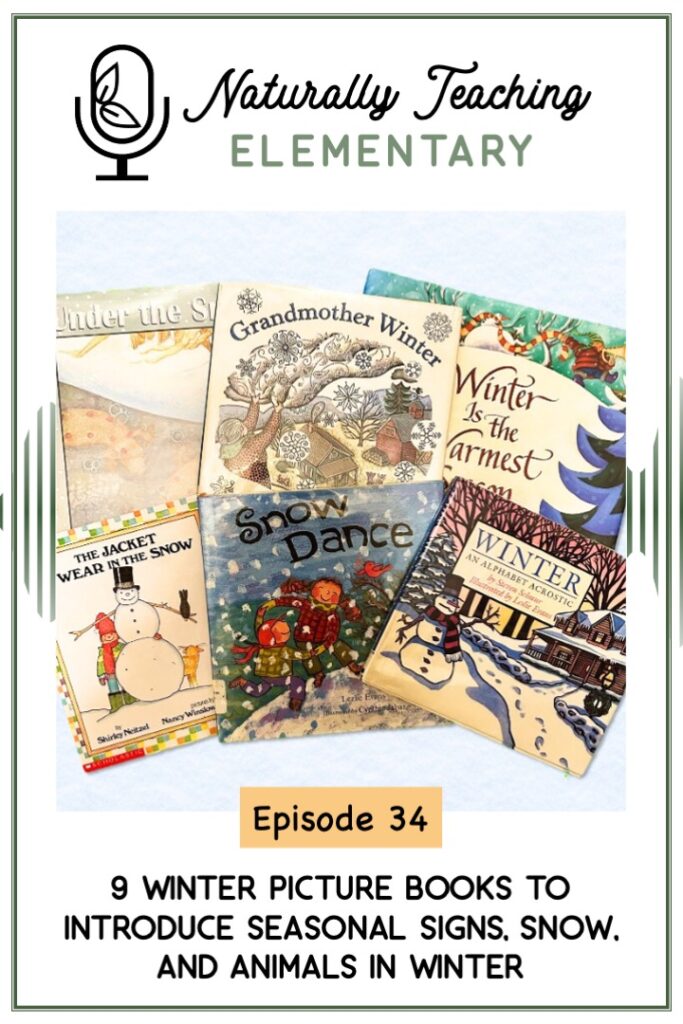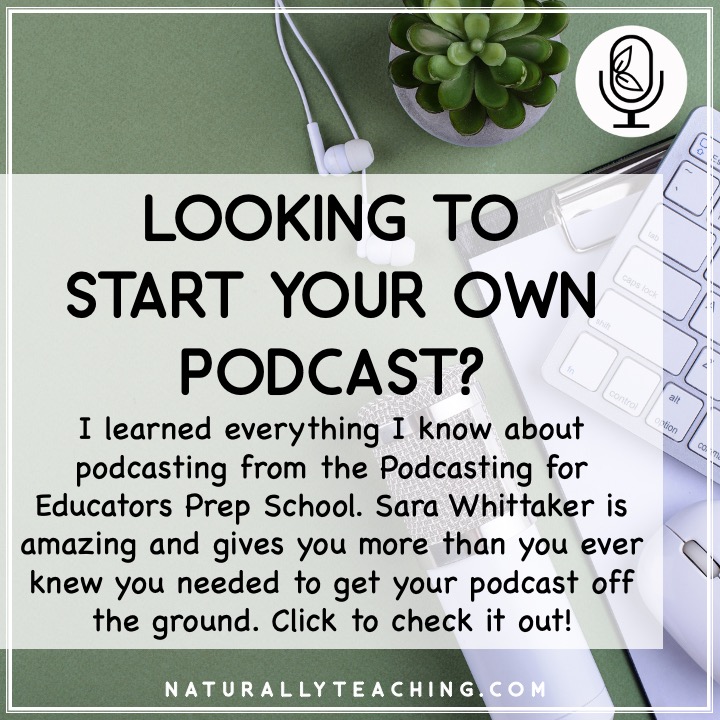Science
Frogs and Toads Together: Why do Amphibians Group Up?April 11, 2025


Affiliate disclosure: As an Amazon Associate, I may earn commissions from qualifying purchases from Amazon.com. This is at no extra cost to you. If you’d like to learn more, check out my disclaimers page.
Winter is here and with it comes a change in weather and fewer hours of daylight. Winter picture books could be just what you need to help introduce your students to the seasonal signs they may see and how plants and animals react to the change in weather and shorter days.
In this episode, I share 9 winter picture books that you can use in your elementary classroom and at home to introduce winter seasonal signs, snow, and animals in winter. Listen in to discover some amazing winter picture books to use this school year.
Winter picture books covered in this episode include:

Affiliate Disclosure
I only endorse things that I’ve personally used, come highly recommended by trusted peers, or I’ve done extensive research on. As an Amazon Associate, I may earn commissions from qualifying purchases from Amazon.com. This is at no extra cost to you, the commission is covered by the company.
I am recommending products that I think will be genuinely helpful and useful, and not because of the small commissions that I receive. Please only purchase items if you believe that they will help you achieve your educational goals. If you’d like to learn more, check out my disclaimers page.
Teaching elementary-aged children is a rewarding experience, but as educators and parents, finding the time and resources to create engaging lessons can be a challenge. That's where this podcast comes in. Welcome to Naturally Teaching Elementary.
I'm Victoria Zablocki, a certified elementary teacher turned outdoor educator. With over a decade of experience coaching teachers on effective teaching methods, I'm passionate about teaching the whole child with authentic and place-based experiences in school and home settings. Join me as we explore our strategies for teaching with practical teaching tips, insightful interviews, picture book reviews, and more.
So let's grow together. Hey, everybody. Welcome to the Naturally Teaching Elementary podcast, formerly known as Naturally Teaching Elementary Science.
I recently changed the name, so if you were confused when you looked at your library, yes, it did change. You can go back to episode 33 to find out why. From 2025 on until the foreseeable future, this podcast will be known as the Naturally Teaching Elementary Podcast.
So let's get into this. Winter is officially here and your students are likely going to have tales of different adventures from their winter activities while on break. Like many animals of the wild, your students may have migrated somewhere warmer for vacation, or some may have stayed home and ate a bunch of food they wouldn't eat in other seasons, or some may have spent the break sleeping in as much as possible.
I'm sure you were hoping to pull off all three of those this break as well, and I hope you did it. Once your students return from break, capture their observations from their unique winter experience and have them identify how they think their noticings relate to the season specifically. After hearing about their experiences, grab a picture book or two to confirm or educate your students about what's happening with weather, plants, and animals during the winter.
Picture books are a great way to explain how plants and animals react to the shift in weather and amount of daylight. And if you're looking for a mini winter unit for kindergartners, check out my Winter Picture Book Companion for Kindergarten in my Teachers Pay Teachers Store. This mini unit includes made-for-you ELA and science activities aligned with the Common Core State Standards and the Next Generation Science Standards.
It includes a suggested picture book list, as well as activities that can pair with almost any picture book about winter. These activities include a simple literature study, a guided opinion writing, completing winter sentences, winter weather foldable data booklet, winter plant color search, finding animal clues, designing a winter animal, and building a winter animal home out of natural materials. And if you've listened to my other episodes about picture books, I'm sure that you've caught on to the fact that I'm very passionate about teaching science concepts with the help of children's literature.
And for good reason. Research has shown that integrating science and literacy has many benefits, including saving teachers time in their schedule, improved attitudes of children towards science, better overall performance in reading and science, and so many more. For more information about benefits and methods for integrating science and literacy, check out my blog post, Teaching with Books: How to Integrate Science and Literacy for Elementary Classrooms, and I'll make sure to put a link for that in the show notes.
[3:04]
All right, so let's get into these books. So book number one is called Winter is the Warmest Season by Lauren Stringer. And you may think, wow, that's quite the statement.
Well, this book talks about all the different ways that a child can experience winter in a warm way. It's got a very positive message behind it. And it shares a variety of different ways on how winter is warm.
So how does this child get dressed to go outside? They put on a jacket with feathers. They put on a hat with ear flaps. They put on fuzzy boots. All of these things that help them stay warm.
They mentioned different things that are happening in nature that are also “warm”, like animals that are sleeping underground and staying warm for the winter instead of being in the snow.
They talk about things that they eat or drink that are warm; soup and hot cocoa, that sort of thing that helps them stay warm from the inside. They also talk about their home coming alive with the furnace warming it up. So this puts a nice spin on the winter season for some of your students that complain about being cold all the time when they're outside.
Just remind them of some of the things from this book after you've read it. It also has a few things from nature as well, but the focus is mostly on people and their experience with winter and its interactions. So if you're looking for a book that's more about the nature side of winter, I wouldn't suggest this book per se, but it's a great way to introduce what they're seeing outside, how they personally are interacting with winter, and it's a good introduction for early childhood kiddos.
[4:30]
Book number two is Grandmother Winter by Phyllis Root. And this book is a folk story about how Grandmother Winter uses her quilt that she's made during the spring, summer, and fall to be able to shake and be able to make snow over top of the people and the land and the animals. In the story, Grandmother Winter collects the snow geese's feathers throughout the spring, summer, and fall, and then she sews them into her white quilt that she then shakes over the land when it's time for it to snow.
Throughout the book, it talks about when Grandmother shakes her quilt… these things will happen, and it mentions how children will put on sweaters and mittens and skis, and the cardinals and chickadees will fluff themselves up against the cold, and the snowshoe hares and weasels will change to white, and the earthworms will tunnel down deep in the dirt, and the brown bats will hang upside down, and a variety of other things that happen in nature when it starts to snow. So even though this book isn't factual in the sense that there's no Grandmother Winter shaking a quilt over top of the earth, it does mention a lot of seasonal signs that winter is here, like the different things that are happening with the animals.
And so in that way, it's kind of interesting to talk about this tall tale, but then also the true side of nature that's happening. It also has incredibly beautiful scratchboard illustrations by Beth Krommes, and so it's a nice one to check out because it's a different sort of illustration than what your students are typically used to.
[5:56]
Book number three is Winter: An Alphabet Acrostic by Steven Schnur. This book also has similar illustrations to Grandmother Winter, but this one's illustrated by Leslie Evans, and it's not quite as scratchboardy, but it's got a similar feel. So the way that Schnur has gone through and written this book is interesting. So he chooses a word that relates to whatever the page is about.
So the first page is awake. He'll make a sentence using each letter to be able to create an acrostic poem. So he talks about the different seasonal signs of winter using different acrostic poems, which is kind of cool and different.
So he covers things like what people change their eating habits to have, what's happening with water, what's happening with different animals, how people change the way they dress in order to stay warm. He mentions snow, of course. And he also mentions a variety of different activities that people can do in the winter that they typically can't in other seasons.
So this book is kind of cool because it expresses a variety of different poems. And it could be a great way to integrate your ELA because you could read this book and then you could have your students go through and write their own acrostic poem that's related to the winter season. Plus, the bonus is if you like this book, he's published a similar book for each season, including Autumn for Fall, Spring and Summer.
[7:18]
Book number four is Snow Dance by Lezlie Evans. Different Lezlie Evans than the illustrator from the last book. But spelled similarly.
Snow Dance is all about doing a snow dance in order to make a snow day happen for students. So this is super relatable for students that are in the public education system or the private education system because most students love snow days. So there's a couple of characters that do a snow dance in an effort to be able to get enough snow to fall to be able to have a snow day.
Spoiler alert, they do it. There's a snow day. And they take full advantage of their snow day.
So they do a variety of different activities that you can't do during the summer or the spring or the fall, it requires snow. So they make snow angels. They make boot prints. They make snowmen. They throw snowballs. They go ice skating.
They go sledding. And then they get to thaw out with some hot cocoa. So even though this one doesn't have a lot of the winter seasonal signs, it's a fun way to embrace snow with your class if you have early childhood students that aren't familiar with snow days.
So it might be a good option for like a kindergarten class that's not familiar with a snow day and what it is. Or it might be just a fun one if you have the possibility of a snow day happening and you want to get the kids really jazzed up. Or you just want to read an awesome book about snow.
[8:38]
Book number five is The Jacket I Wear in the Snow by Shirley Neitzel. And this book is a good book to use for teaching your students what to wear to stay warm during the winter time. So it goes along to the song “The House That Jack Built”.
And it's a variety of different things that a child would put on their body in order to stay warm in the snow. So there's the jacket, the zipper, the scarf, the hat, the mittens, the sweater, the pants, the boots, the long johns, and the socks that this child puts on. And the author uses the rhythm of the song “The House That Jack Built” in order to repeat and teach children over and over the different things that they can use to stay warm in the winter time.
[9:20]
Book number six is Animals in Winter by Henrietta Bancroft and Richard G. VanGelder. And this book is all about animals in winter, go figure.
But this book doesn't just hit on hibernation or just migration. This book includes a variety of different animal adaptations for winter survival. So the book actually starts in the fall, and it talks about animals that migrate, so leave from where they are to go south, where they can find food that will keep them alive during the winter time.
And as the book progresses, it moves more into winter. So then it starts talking about animals that go to sleep, hibernate, torpor otherwise. So they mention bats, woodchucks, and pikas.
And then they also talk about animals that gather food and hide them so that they can stay active during the winter time, like squirrels. They also talk about animals that don't do anything special to get ready for winter. So one example would be mice.
They also talk about other animals that are awake during the winter time, including deer, rabbits, and foxes. This book is a great option for introductions to different animal adaptations. And it provides a variety of smattering, which is kind of nice.
[10:31]
Book number seven is Under the Snow by Melissa Stewart. This book is similar to Animals in Winter because it provides a variety of different techniques that animals use to survive winter, but specifically being under the snow. So it talks about animals that sleep.
So we've got diapause with ladybugs, we've got brumation with snakes, we've got torpor with chipmunks, and hibernation with woodchucks. They also talk about animals that use the subnivean layer without specifically saying subnivean layer, like the voles that spend their days tunneling through the snow. They also talk about fish and what they're doing under the water, which is interesting because a lot of books don't mention that, and it is a big curiosity for kids.
They also mention animals that are awake underwater, like beavers and what they're doing during the wintertime. And then the book ends when things thaw out and spring happens. So this is another great option for introducing animal adaptations during a time of scarcity, and I really enjoy this book and its illustrations and its introductions for animals.
I would say that this one is probably a little bit older than your Animals in Winter option. So if you have early childhood students, animals in winter would be more appropriate. And then if you have upper elementary aged students, that would be Under the Snow; that would be a better fit for them.
[11:47]
Book number eight is actually a math book, and it's called Sizing Up Winter by Lizann Flatt. This book provides a variety of mathematical vocabulary alongside with science and seasonal signs of what's happening in winter.
So this book starts with counting snowflakes and how it can help you see the distance between where a snowy owl is flying and where they fly to. There's an opportunity to count how many steps an animal takes compared to another animal. There's an opportunity to compare the mass of an adult polar bear compared to her cubs and who might have more mass.
There's an opportunity to tell time using animals in their position. There's an opportunity to use comparison words like fattest and tallest and longest. And there's also opportunities to check out calendars.
There's more that I'm not mentioning, but this does seem like math vocabulary for early childhood learners, so I would say this book would be more appropriate for your lower elementary aged students or kiddos at home.
[12:54]
Book number nine is Wait, Rest, Pause: Dormancy in Nature by Marcie Flinchum Atkins. And this book is cool because it talks about dormancy in nature, which is the ways that animals and organisms use sleep to survive winter.
And if you want to hear more about dormancy, what that means and the different types, you could go back to episode 29, which is Hibernation in Animals: Six Dormancy Activities for Elementary Teachers and Homeschool Groups, and I explained the science behind it. So talking about hibernation, torpor, brumation, and diapause. And then also episode 30 is 10 books specifically on hibernation and other forms of dormancy for elementary teachers and homeschool groups.
I did not mention this book though. This book is different. And in this book, they actually talk about plants, not just animals.
So I was having a hard time finding any books that were specifically about plants in winter that were quality. There are a fair number out there, but I didn't find any that I got really jazzed up about. But this one does talk about if you were a dormant tree, what you would do.
Plus, it also talks about a variety of different animals who are dormant. So you've got animals that go through diapause like ladybugs. They also talk about hibernators like the Arctic ground squirrel.
They also talk about the black-capped chickadee, which is cool because they only torpor, which is a form of dormancy, for a few hours. So it's not like they're going to sleep for three days. They only do it for a few hours.
So that's a cool thing that they add in this book that other books don't address. They also hit on other animals as well. So this book is like a nice introduction to dormancy specifically, organisms that go through a sleep like state to be able to survive winter.
So it doesn't include other adaptations like Under the Snow or Animals in Winter, but it's a great introduction for dormancy for survival in winter.
[14:41]
So in a nutshell, we talked about nine winter picture books to introduce seasonal signs, snow, and what animals do in the winter. Titles that were summarized today include Winter is the Warmest Season by Lauren Stringer, Grandmother Winter by Phyllis Root, Winter: An Alphabet Acrostic by Steven Schnur, Snow Dance by Leslie Evans, The Jacket I Wear in the Snow by Shirley Neitzel, Animals in Winter by Henrietta Bancroft and Richard G.VanGelder, Under the Snow by Melissa Stewart, Sizing Up Winter by Lizann Flatt, and Wait, Rest, Pause: Dormancy in Nature by Marcy Flinchum Atkins.
If you're looking for more winter picture books, check out my article, “16 Wonderful Children's Books About Winter for Elementary Teachers” on naturallyteaching.com or follow the link in the show notes. There's different books on that list.
The only one I repeated was Animals in Winter. Don't forget, if you're looking for a mini winter unit for kindergarteners that coordinate with these books, check out my winter picture book companion for kindergarten in my Teachers Pay Teachers store. So thanks for taking time to listen today.
I know you're busy and I truly appreciate the time you take to tune in. If you have any questions, wonderings, or winter picture books that you like to read, get a hold of me on Instagram at naturally.teaching, or you can email me at victoria@naturallyteaching.com. Don't forget to check out the show notes for this episode at naturallyteaching.com/episode34 for all those links that I mentioned.
Thanks again for joining me today. Until next time, keep exploring, keep learning, and keep naturally teaching.
Thank you so much for tuning in to today's episode of the Naturally Teaching Elementary Podcast. I hope you found it informative, inspiring, and full of actionable insights to enhance your teaching journey. Connect with me on social media for more updates, science tidbits, and additional resources. You can find me on Instagram and Facebook at naturally.teaching.
Let's continue the conversation and share our passion for teaching elementary age children together. Don't forget to visit my website at naturallyteaching.com for all the show notes from today's episode. If you enjoyed today's episode, please consider leaving a review on your favorite podcast platform.
Your feedback helps me improve and reach more educators like you. Thank you again for listening, and until next time, keep exploring, keep learning, and keep naturally teaching.


0